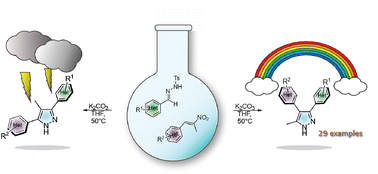A regioselective synthesis of 3,4-diaryl-1H-pyrazoles through a 1,3-dipolar cycloaddition of tosylhydrazones and nitroalkenes†
Abstract
A procedure for the selective synthesis of 3,4-diaryl-1H-pyrazoles through a 1,3-dipolar cycloaddition is reported. The transformation occurred under mild conditions using affordable tosylhydrazones and nitroalkenes commencing from benzaldehydes/heteroaromatic aldehydes as starting materials. Due to the versatility of this protocol, we prepared a vast collection of 3,4-diaryl-1H-pyrazoles, which included the incorporation of heterocyclic rings at the pyrazole core. Two-dimensional NMR techniques (2D-NOESY and HMBC) confirmed the regioselectivity of the transformation and correlated well with DFT calculations. Accordingly, the analysis of the transition states indicated that the 3,4-diaryl product corresponded to the product with the lowest activation energy and led to the most stable product. Finally, the series was evaluated against three cancer cell lines, with compound 8f being the most remarkable analog in terms of activity and extraordinary selectivity towards PC-3 compared to the other cell lines (including COS-7).



 Please wait while we load your content...
Please wait while we load your content...